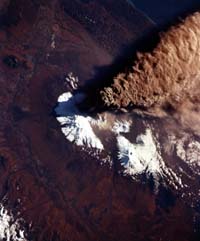Danger to Aircraft from Volcanic Eruption Clouds and Volcanic Ash
Eruption Cloud from Kliuchevskoi Volcano, Kamchatka Peninsula, Russia, 1 October 1994 - Images from the Space Shuttle Endeavour (mission STS 68)

Clearly visible to astronauts aboard the Endeavor Space Shuttle, this spectacular eruption cloud shoots nearly 20 km into the atmosphere. As the cloud of ash and gas moves away from the volcano, it loses altitude and ash falls to the ground, forming a dense curtain of ash that threatens aircraft in the way.

Wind carries volcanic ash and gas from the volcano toward the southeast, out over the Pacific Ocean directly toward some of the busiest air routes between Asia and both Europe and the United States. One Boeing-747 aircraft reported encountering ash at about 11 km above sea level, but was able to get out of the eruption cloud by climbing up to 12 km.

Downwind from an erupting volcano, pilots have a very difficult time distinguishing eruption clouds from weather-related clouds. Detecting explosive volcanic eruptions and locating the eruption cloud downwind is crucial to aviation safety because ash can cause an aircraft to lose power in all engines in less than a minute. This eruption cloud extended more than 800 km downwind and covered an area of 150,000 km2.
What can volcanic ash do to aircraft?

More than 80 commercial aircraft have unexpectedly encountered volcanic ash in flight and at airports in the past 15 years. Seven of these encounters caused in-flight loss of jet engine power, which nearly resulted in the crash of the airplane. A range of damage may occur to airplanes that fly through an eruption cloud depending on the concentration of volcanic ash and gas aerosols in the cloud, the length of time the aircraft actually spends in the cloud, and the actions taken by the pilots to exit the cloud.
Ash Reduces Engine Performance and May Cause Engine Failure
Ash ingested by jet engines may lead to the immediate deterioration in engine performance and engine failure. The principal cause of engine failure is the deposition of ash in the hot sections of the engine. Glass from melting volcanic ash will coat fuel nozzles, the combustor, and turbine, which reduces the efficiency of fuel mixing and restricts air passing through the engine. This causes surging, flame out, and immediate loss of engine thrust. Ash may also seriously erode moving engine parts, including the compressor and turbine blades, which reduces the efficiency of the engine.
Ash Abrades External Components of Airplanes
Volcanic ash is highly abrasive because it consists of hard, sharp rock fragments that easily scratch and erode plastic, glass, and metals. Any forward-facing surface of an airplane is likely to be damaged, including the cockpit and forward cabin windows, landing light covers, leading edges of wings and tail rudder, engine cowlings, and the radar nose cone. Cockpit windows may become so abraded and scratched that pilots have extreme difficulty seeing the runway on which to land the plane.
Ash Contaminates Interior of Airplanes
Air that enters an airplane's interior first passes through the engines. Some ash particles ingested through the engines will travel through the plane's ventilation ductwork throughout the plane. The ash may clog air-filter systems and spread throughout the cabin, contaminating cabin fixtures, carpeting, seat covers, and cushions. The ash can also damage the plane's electronic system, including power generators and navigation instruments.
Volcanic Ash Advisory Centers

Eruption column at
Redoubt Volcano,
Alaska
Explosive eruptions of Redoubt (left) and Mt. Spurr volcanoes in Alaska in 1989-90 and 1992, respectively, highlighted the impact of ash clouds on aircraft and the international aviation industry in areas of active volcanism. Expanded monitoring by the USGS of volcanoes in the Alaskan Peninsula and the Aleutians and cooperative agreements with NOAA, FAA, and other agencies resulted, and vastly improved ash cloud-notification procedures were developed for the Volcanic Ash Advisory Centers (VAAC's).
The VAACs were established in September 1995 in Darwin, Australia, at a meeting of the International Civil Aviation Organization (ICAO). At this meeting it was decided that to ensure that volcanic cloud hazards were addressed there must be an an interface between volcano observatories, meteorological agencies and air traffic control centers.
In order to meet their goal they decided the world should be divided into different regions by their volcanic activity and volcano observatories in the designated regions would be in charge of keeping track of the activity in their area by analyzing satellite imagery.
More information about volcanic ash and aircraft safety issues
- Volcanic Ash Site
- Fact Sheet: Volcanic Ash--Danger to Aircraft in the North Pacific
- Casadevall, Thomas, J., editor, 1994, Volcanic Ash and Aviation Safety: Proceedings of the First International Symposium on Volcanic Ash and Aviation Safety: U.S. Geological Survey USGS Bulletin 2047, 450 p.
- Casedevall, Thomas, J, and Thompson, Theodore, B., 1995, World Map of Volcanoes and Principal Aeronautical Features: U.S. Geological Survey Geophysical Investigation Series, Map GP-1011.

